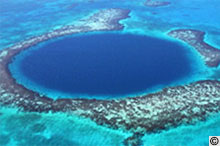Beyond Belize’s barrier reef are three of the Western Hemisphere’s four atolls – groups of islands and reef that encircle a central lagoon. The formation of these deep reefs was a mystery to geologists because reefs are only supposed to grow in shallow water (as they need sunlight). Darwin explained the paradox: originally an island with a shallow fringing reef, the reef continually grows upward as the island erodes and sinks, becoming the central lagoon. The coral reef of all 3 atolls covers as much surface area as the barrier reef itself! Their unique geology also explains why most of the dive sites are walls. For example, the eastern slope of Glover’s Reef Atoll descends 15,000 feet into the Caiman Trench, one of the deepest in the world. The relative isolation of the atolls, well removed from commercial fishing grounds, produces an abundance of marine life. This not only makes for good diving but excellent fishing as well.
Lighthouse Reef Atoll

The Blue Hole is over 400 feet deep and is a famed dive site in Belize.
The outermost of the 3 atolls, it sits 50 miles off the coast. The Blue Hole in the central lagoon (first explored by Jacques Cousteau) is an almost perfect circular sinkhole that drops to 412 feet. The outer shallow edge is lined by corals while its depths harbor large stalactites and resident bull and tiger sharks. The walls of Half Moon and Long Caye are fed by nutrient rich currents, resulting in abundant marine life and well developed corals. Half Moon Caye sits on the southern end of the atoll and was designated a UN World Heritage Site in 1982. From the observation tower, looking over the ziricote forest canopy, you can observe hundreds of nesting red-footed booby birds. Standing on the crescent-shaped beach (easily one of the nicest in the country) you can see one of the 6 wrecks that line the eastern reef of the atoll, looming over the shallow coral.
Turneffe Islands Atoll
The largest and closest of the 3 atolls, it sits a mere 25 miles off the coast. It is the only atoll with over 200 mangrove islands within the lagoon. They create a maze of channels and, of particular interest to anglers, miles of saltwater flats. The mangroves act as important fish nurseries resulting in abundant marine life, making it the most renowned atoll for fishing. Novice divers will feel more comfortable in the shallow reefs on the western edge. Experienced divers can enjoy the steep walls on the eastern edge, also home to the wreck, Sayonara. The best known dive site is the Elbow, a section of reef that juts out of the southern tip. A constant supply of nutrients brought through by currents (it’s primarily a drift dive) attract very large schools of snappers and jacks in mid-water above the reefs. Eagle rays are also quite common.
Glover’s Reef Atoll

Glover’s Reef is a UN World Heritage Site with abundant marine life.
Just south of Turneffe, it sits 36 miles off the coast. It was ounce the base of pirate John Glover. With an 80-square mile almost continuous ring of coral reef, it is considered the most developed atoll in the Caribbean and harbors the greatest diversity of reef types. In 1993, it was established as a marine reserve (the largest in the country). In 1996, it was again given protected status as a UN World Heritage Site. The lagoon is dotted with some 700 shallow coral patches and surrounded by sheer drop-offs for excellent wall diving. The no-fishing restrictions and relative isolation allow for abundant marine life. In April, May and June whale sharks can be seen in the nearby Gladden Split. Along the eastern edge are many shipwrecks that have accumulated over centuries. A combination of zone and seasonal fishing allows anglers to enjoy this atoll without affecting fish populations.
